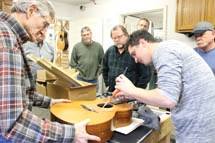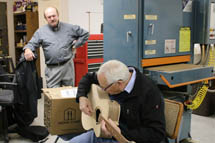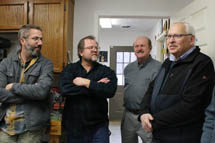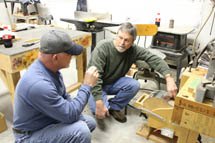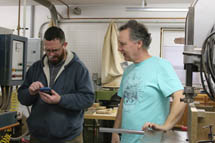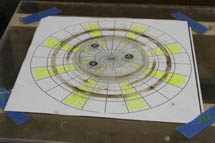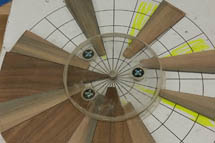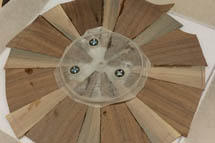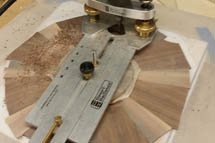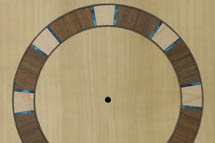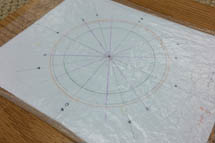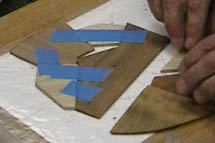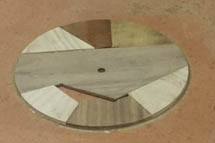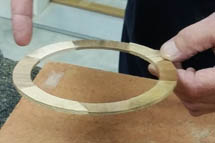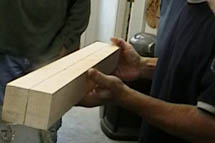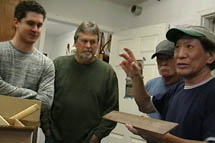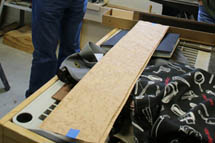Meeting
Jan 22, 2017
Click on any image to start the slide show.
"Inventing the American Guitar"
Jack brought the book, "Inventing the American Guitar", The Pre-Civil War Innovations of C.F. Martin and His Contemporaries, Edited by Robert Shaw & Peter Szego.
He brough it to show some of the interesting features of these early guitars. Maybe one of us might be interested in building a replica of one of these early instruments.
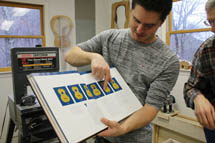
"Green Ebony" Violin
Mark brought a violin that has fallen apart (probably stuck in a hot attic for some time). It is made from a wood the Dominicans call "green ebony" but its latin name is Magnolia Pallescens. The violin was an experiment by Mark's distant great uncle. More info here.

Chet's 'Roy Smeck model' Uke
The uke is a "Roy Smeck" model made by Harmony (in Chicago) in the 1950s. It is all solid Mahogany with a plastic fretboard that has molded in frets. The Roy Smeck model was first introduced in 1928 and sold by Sears and Roebuck.
From Wikipedia:
Roy Smeck
(born Leroy Smeck, 6 February 1900 – 5 April 1994) was an American musician.
His skill on the banjo, guitar, steel guitar, and especially the ukulele earned him the nickname "Wizard of the Strings."


Meeting Jan 22, 2017 - Chet Dickerson's Shop in Roanoke, VA
Main Event: making a radial rosette. We got a new member, Michael Dean. Other topics included Jumbo bracing, banjo necks, walnut fretboards, Uke under construction, armrest/ribrest bevel...
Making a Radial Rosette
We showed two methods - one using a jig and the other without a jig. You can get some radial templates here.

Method 1 - Using Frank Riner's jig
that he fashioned after the one in this video, "Making The Rosette - Eric Schaefer Guitars - Online Guitar Building School." Frank used Super Glue (CA) for joining the pieces.
One advantage of the jig is that the center plexiglass clamp provides a center point for cutting the rosette.
One disadvantage is that the plexiglas base can melt when the bit hits the base while cutting the rosette.

Method 2 - Making the rosette without a jig.
The base for building is a piece of flat wood with the paper template on it covered by a piece of wax paper. The wax paper allows you to see the template and prevents the rosette from being glued to the template.
Without the jig, you need to provide material for the centering hole, either while laying out the rosette (as in this demo) or adding material to the center later. This is easily done with scrap wood and some 5 min epoxy.
Larry used Titebond for to glue the segemnts of this rosette.
Jack's Banjo Projects
I am starting work on 4 banjos that I will build in parallel. Each will differ significantly from the others. One will use a walnut neck, maple rim (covered with birdseye veneer), and birdseye accents. It will be a fretted version of mid-19th century banjo, which was uncommon, but there were some. The design will be period inspired but original.
Each banjo will use a different material for the neck - maple, walnut, cherry, and mahogany. Also, fingerboards will vary -- ebony, rosewood, walnut, and perhaps cherry. I was glad to learn of the success several of you have had with walnut and cherry for finger boards, since I think I will increasingly use only domestic woods.


